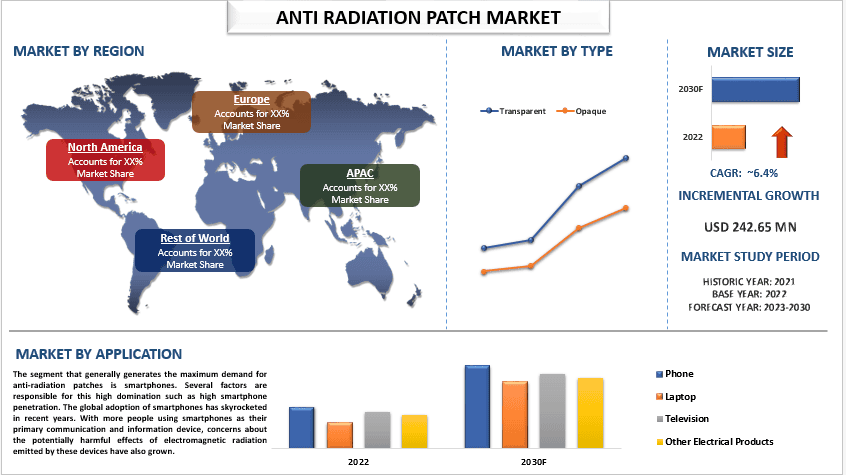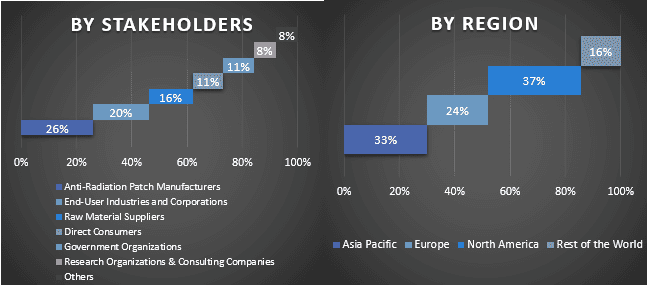- Home
- About Us
- Industry
- Services
- Reading
- Contact Us
Anti-Radiation Patch Market: Current Analysis and Forecast (2023-2030)
Emphasis on Type (Transparent and Opaque), Application (Phone, Laptop, Television, and Other Electrical Equipment); and Region/Country

The Anti-Radiation Patch Market was valued at 242.65 million in the year 2022 and is expected to grow at a strong rate of around 6.4% during the forecast period (2023-2030), owing to the growing penetration of electronic devices and wearables with connectivity. Furthermore, in recent times, the use of electronic devices and wearables has witnessed an unprecedented surge. Smartphones have become ubiquitous, and people rely on them for communication, work, and entertainment. Additionally, wearable devices such as smartwatches, fitness trackers, and augmented reality glasses have gained popularity for their various functionalities. These devices emit electromagnetic radiation, commonly known as radiofrequency (RF) radiation, which is a type of non-ionizing radiation. As the use of electronic devices continues to expand, so does the awareness about potential health risks associated with prolonged exposure to RF radiation. Some studies suggest that long-term exposure to high levels may increase the risk of certain health issues, including cancer, infertility, and neurological disorders. This has raised concerns among health-conscious individuals worldwide, leading to a greater demand for protection against these potential risks. Anti-radiation patches have emerged as a popular solution for those seeking to mitigate the potential risks of RF radiation from electronic devices and wearables. These patches are designed to absorb, deflect, or neutralize the harmful radiation emitted by these devices, thereby reducing exposure.
Some of the major players operating in the market include EMF Harmony; Smart&Safe; Apex Telecom; SafeSleeve; LessEMF; Airestech; Belly Armor; Bodywell; Comosystems SL; and DefenderShield. Several M&As along with partnerships have been undertaken by these players to facilitate customers with hi-tech and innovative products/technologies.
Insights Presented in the Report
“Amongst Type, the opaque anti-radiation patch segment held the significant market share in 2022.”
Based on type, the market is bifurcated into transparent and opaque. In the global market, the opaque anti-radiation patch holds the majority share compared to the transparent anti-radiation patch. Several factors contribute to the domination such as enhanced protection. Opaque patches generally provide stronger protection against radiation due to the materials used in their construction. This makes them more appealing to users who prioritize effectiveness. Furthermore, opaque patches tend to be more affordable compared to transparent patches due to their simpler manufacturing process and lower material costs. This affordability contributes to their market dominance.
“Amongst application, the Phone industry held a significant share of the market in 2022.”
Based on application, the market is segmented into phones, laptops, televisions, and other electronic devices. The segment that generally generates the maximum demand for anti-radiation patches is smartphones. Several factors are responsible for this high domination such as high smartphone penetration. The global adoption of smartphones has skyrocketed in recent years. With more people using smartphones as their primary communication and information device, concerns about the potentially harmful effects of electromagnetic radiation emitted by these devices have also grown. For instance, Globally, there were 4.4 billion mobile internet users in 2022, equivalent to 55% penetration. Furthermore, the rapid expansion of 5G networks and the increasing penetration of smartphones have revolutionized the way we communicate and access information. However, concerns about the potential health effects of electromagnetic radiation emitted by these technologies have also grown. As a result, the global demand for anti-radiation patches has witnessed a significant surge.
“North America is anticipated to witness a significant growth during the forecast year (2023-2030).”
The North American region stands at the forefront of the 5G rollout and has experienced substantial smartphone penetration. This, coupled with the region’s strong consumer awareness and health consciousness, has created a lucrative market for anti-radiation patches. In recent years, North America has witnessed a surge in the availability and sales of anti-radiation patches from both local and international manufacturers. Additionally, the region has seen the emergence of dedicated online platforms and retail stores catering to the growing demand for these products. With an increasing number of people seeking ways to mitigate potential health risks, the market for anti-radiation patches is expected to grow further. Moreover, as consumer concerns continue to fuel the demand for anti-radiation patches, governments and health agencies are also taking proactive measures. Regulatory bodies are intensifying research and implementing safety guidelines to assess and mitigate potential health risks associated with prolonged exposure to electromagnetic radiation.
Anti-Radiation Patch Market Report Coverage

Reasons to buy this report:
- The study includes market sizing and forecasting analysis validated by authenticated key industry experts.
- The report presents a quick review of overall industry performance at one glance.
- The report covers an in-depth analysis of prominent industry peers with a primary focus on key business financials, product portfolios, expansion strategies, and recent developments.
- Detailed examination of drivers, restraints, key trends, and opportunities prevailing in the industry.
- The study comprehensively covers the market across different segments.
- Deep dive regional level analysis of the industry.
Customization Options:
The global anti-radiation patch market can further be customized as per the requirement or any other market segment. Besides this, UMI understands that you may have your own business needs, hence feel free to contact us to get a report that completely suits your requirements.
Table of Content
Research Methodology for the Anti-Radiation Patch Market Analysis (2023-2030)
Analyzing the historical market, estimating the current market, and forecasting the future market of the global anti-radiation patch market were the three major steps undertaken to create and analyze the adoption of anti-radiation patches in major regions globally. Exhaustive secondary research was conducted to collect the historical market numbers and estimate the current market size. Secondly, to validate these insights, numerous findings and assumptions were taken into consideration. Moreover, exhaustive primary interviews were also conducted, with industry experts across the value chain of the global anti-radiation patch market. Post assumption and validation of market numbers through primary interviews, we employed a top-down/bottom-up approach to forecasting the complete market size. Thereafter, market breakdown and data triangulation methods were adopted to estimate and analyze the market size of segments and sub-segments of the industry pertains to. Detailed methodology is explained below:
Analysis of Historical Market Size
Step 1: In-Depth Study of Secondary Sources:
A detailed secondary study was conducted to obtain the historical market size of the anti-radiation patch market through company internal sources such as annual reports & financial statements, performance presentations, press releases, etc., and external sources including journals, news & articles, government publications, competitor publications, sector reports, third-party database, and other credible publications.
Step 2: Market Segmentation:
After obtaining the historical market size of the anti-radiation patch market, we conducted a detailed secondary analysis to gather historical market insights and share for different segments & sub-segments for major regions. Major segments are included in the report as type and application. Further country-level analyses were conducted to evaluate the overall adoption of testing models in that region.
Step 3: Factor Analysis:
After acquiring the historical market size of different segments and sub-segments, we conducted a detailed factor analysis to estimate the current market size of the Anti-Radiation Patch market. Further, we conducted factor analysis using dependent and independent variables such as the type and application of the anti-radiation patch market. A thorough analysis was conducted for demand and supply-side scenarios considering top partnerships, mergers and acquisitions, business expansion, and product launches in the anti-radiation patch market sector across the globe.
Current Market Size Estimate & Forecast
Current Market Sizing: Based on actionable insights from the above 3 steps, we arrived at the current market size, key players in the global Anti-Radiation Patch market, and market shares of the segments. All the required percentage shares split and market breakdowns were determined using the above-mentioned secondary approach and were verified through primary interviews.
Estimation & Forecasting: For market estimation and forecast, weights were assigned to different factors including drivers & trends, restraints, and opportunities available for the stakeholders. After analyzing these factors, relevant forecasting techniques i.e., the top-down/bottom-up approach were applied to arrive at the market forecast for 2030 for different segments and sub-segments across the major markets globally. The research methodology adopted to estimate the market size encompasses:
- The industry’s market size, in terms of revenue (USD) and the adoption rate of the anti-radiation patch market across the major markets domestically
- All percentage shares, splits, and breakdowns of market segments and sub-segments
- Key players in the global anti-radiation patch market in terms of products offered. Also, the growth strategies adopted by these players to compete in the fast-growing market.
Market Size and Share Validation
Primary Research: In-depth interviews were conducted with the Key Opinion Leaders (KOLs) including Top Level Executives (CXO/VPs, Sales Head, Marketing Head, Operational Head, Regional Head, Country Head, etc.) across major regions. Primary research findings were then summarized, and statistical analysis was performed to prove the stated hypothesis. Inputs from primary research were consolidated with secondary findings, hence turning information into actionable insights.
Split of Primary Participants in Different Regions

Market Engineering
The data triangulation technique was employed to complete the overall market estimation and to arrive at precise statistical numbers for each segment and sub-segment of the global anti-radiation patch market. data was split into several segments & sub-segments after studying various parameters and trends in the areas of type and application in the global anti-radiation patch market.
The main objective of the Global Anti-Radiation Patch Market Study
The current & future market trends of the global anti-radiation patch market were pinpointed in the study. Investors can gain strategic insights to base their discretion for investments on the qualitative and quantitative analysis performed in the study. Current and future market trends determined the overall attractiveness of the market at a regional level, providing a platform for the industrial participant to exploit the untapped market to benefit from a first-mover advantage. Other quantitative goals of the studies include:
- Analyze the current and forecast market size of the anti-radiation patch market in terms of value (USD). Also, analyze the current and forecast market size of different segments and sub-segments.
- Segments in the study include areas of type and application.
- Define and analyze the regulatory framework for the anti-radiation patch
- Analyze the value chain involved with the presence of various intermediaries, along with analyzing customer and competitor behaviors of the industry.
- Analyze the current and forecast market size of the anti-radiation patch market for the major region
- Major countries of regions studied in the report include Asia Pacific, Europe, North America, and the Rest of the World
- Company profiles of the anti-radiation patch market and the growth strategies adopted by the market players to sustain in the fast-growing market
- Deep dive regional level analysis of the industry
Frequently Asked Questions FAQs
Q1: What is the current market size and growth potential of the global Anti-Radiation Patch market?
Q2: What are the driving factors for the growth of the global Anti-Radiation Patch Market?
Q3: Which segment has the largest share of the global Anti-Radiation Patch market by Type?
Q4: What are the emerging technologies and trends in the global Anti-Radiation Patch market?
Q5: Which region is the fastest growing in the global Anti-Radiation Patch market?
Q6: Who are the key players in the global Anti-Radiation Patch market?
Related Reports
Customers who bought this item also bought










